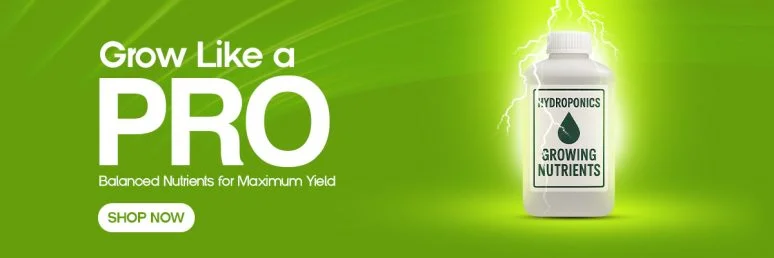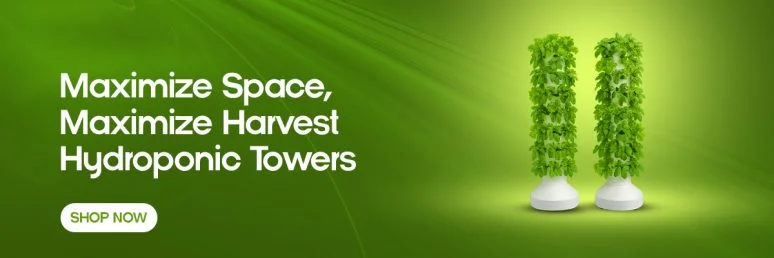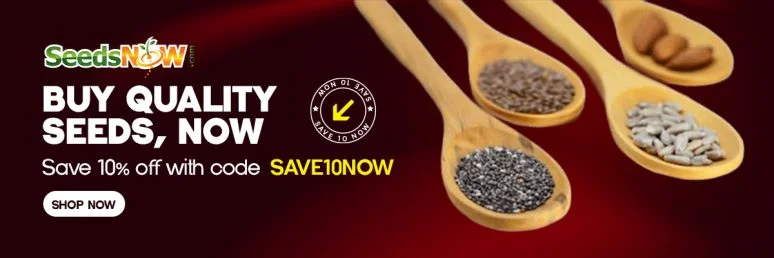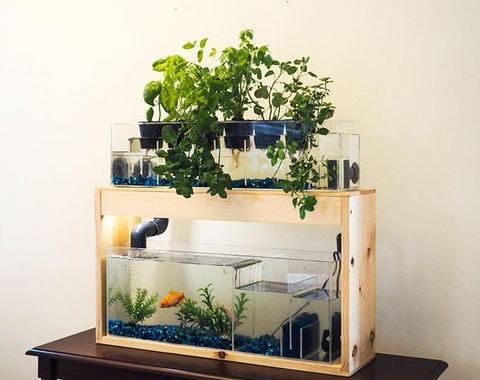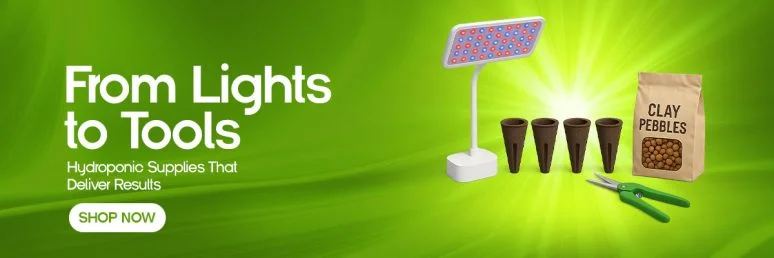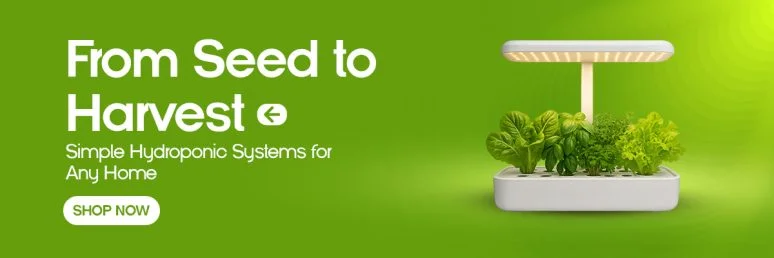Setting Up a Fishtank Hydroponics System: 5 Steps To Success
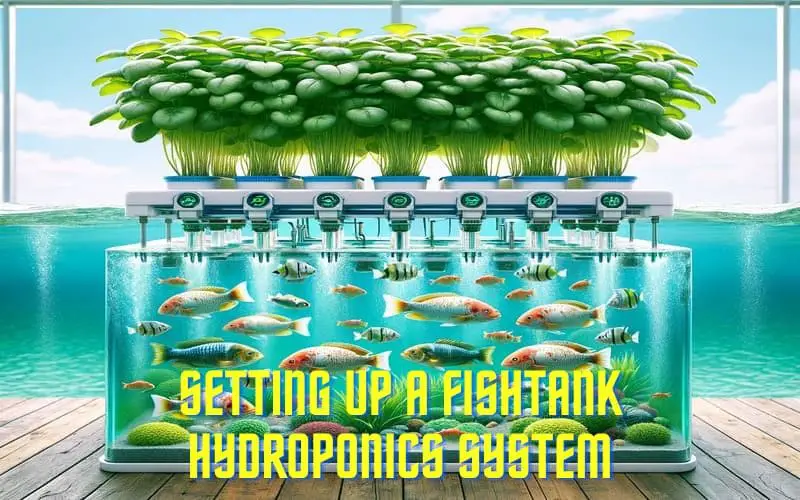
Article-At-A-Glance
- Fish tank hydroponics (aquaponics) creates a self-sustaining ecosystem where fish waste nourishes plants while plants clean the water for fish.
- A basic setup requires just a 10-30 gallon tank, pump, growing media, and appropriate fish species like goldfish or guppies.
- This system uses up to 90% less water than traditional gardening while producing food year-round in limited spaces.
- The nitrogen cycle is crucial – it converts toxic ammonia from fish waste into nitrates that feed your plants.
- AquaGarden Systems offers complete starter kits that simplify the entire setup process for beginners looking to harvest their first homegrown produce.
Imagine harvesting fresh herbs and vegetables right from your living room, all while watching beautiful fish swim beneath them. That’s the magic of fish tank hydroponics, also known as aquaponics. This ingenious growing method creates a perfect closed-loop system where fish provide nutrients for plants, and plants naturally filter the water for the fish. If you’ve been curious about sustainable indoor gardening that works year-round, AquaGarden Systems’ innovative approach to fish tank hydroponics might be exactly what you’ve been looking for.
I’ve helped hundreds of home gardeners transform ordinary fish tanks into thriving food production systems. The beauty of this approach is its elegant simplicity – nature does most of the work once you’ve set things up correctly. Let’s dive into how you can create your own miniature ecosystem that produces food while using a fraction of the resources required by conventional gardening.
What You’ll Learn: Growing Food With Fish Power
Fish tank hydroponics combines two ancient practices – keeping fish and growing plants – into one modern, space-efficient system. Unlike traditional gardening that requires soil, aquaponics uses the natural nitrogen cycle to convert fish waste into perfect plant food. This guide will walk you through creating a system that’s not just productive but also beautiful enough to display proudly in your home.
You’ll discover how to select the right components, establish the critical nitrogen cycle, choose appropriate fish and plants, and maintain the perfect balance between all living elements. The result? A mini-ecosystem that produces fresh organic food with minimal input from you.
Fish Tank Hydroponics: The Perfect Sustainable Growing System
“Hydroponic Garden Aquaponic Fish Tank …” from www.amazon.com and used with no modifications.
The genius of fish tank hydroponics lies in its elegant efficiency. Fish eat food and produce waste containing ammonia. Beneficial bacteria convert this ammonia first into nitrites and then into nitrates – the perfect fertilizer for plants. As plants absorb these nutrients, they simultaneously clean the water for your fish. This creates a beautiful symbiotic relationship where each element supports the others.
“The fish feed the plants, the plants clean the water, and the microbes make it all possible. It’s nature’s perfect partnership.” – Dr. James Rakocy, Father of Aquaponics
This system dramatically reduces the environmental footprint of food production. You’ll use up to 90% less water than traditional gardening since the water continuously recirculates instead of draining away. There’s no need for chemical fertilizers, as your fish provide all the nutrients your plants need. And because everything happens indoors, you can grow year-round regardless of outside weather conditions.
Why Fish Waste Creates Plant-Growing Magic
The secret to aquaponics success is the nitrogen cycle – a natural process that transforms fish waste into perfect plant nutrition. When fish excrete waste, it releases ammonia into the water. In excessive amounts, this ammonia would be toxic to the fish. But in your carefully balanced system, beneficial bacteria colonies establish themselves in your filter media and growing beds.
These bacteria perform a two-stage conversion process. First, Nitrosomonas bacteria convert ammonia (NH₃) to nitrites (NO₂⁻). Then Nitrobacter bacteria transform these nitrites into nitrates (NO₃⁻). Plants thrive on these nitrates, absorbing them through their roots. This continuous cycle creates a self-sustaining ecosystem where fish waste becomes valuable plant nutrition rather than a pollutant.
The beauty of this system is that once properly established, it reaches a natural equilibrium. The fish produce just enough waste to feed the plants, and the plants clean just enough water to keep the fish healthy. This balance makes aquaponics one of the most sustainable food production methods available to home gardeners.
Space-Saving Benefits for Apartment Dwellers
Living in a small apartment doesn’t mean you can’t grow your own food. A fish tank hydroponics setup occupies minimal floor space while producing impressive yields. A standard 20-gallon aquarium with a grow bed on top requires just two square feet of space yet can produce dozens of herb plants or leafy greens continuously. By growing vertically, you can maximize production in even the tightest quarters.
Using 90% Less Water Than Traditional Gardens
The water efficiency of aquaponics is truly remarkable. While traditional gardening loses water to soil absorption and evaporation, an aquaponics system recirculates the same water continuously. You’ll typically only need to top off what’s lost to evaporation and transpiration – usually just 1-2% of your total water volume per day. This makes fish tank hydroponics ideal for water-conscious gardeners and those living in drought-prone regions.
In practice, this means a 20-gallon system might only require half a gallon of fresh water weekly – compared to the dozens of gallons a similar-sized soil garden would demand. Over a year, this water savings becomes substantial while producing the same amount of food.
Step 1: Choose the Right Tank and Components
| Component | Purpose | Recommended Options |
|---|---|---|
| Fish Tank | Houses fish and water | 10-30 gallon glass or acrylic aquarium |
| Grow Bed | Supports plants | Food-grade plastic container or purpose-built grow bed |
| Water Pump | Circulates water | Submersible aquarium pump (100-300 GPH) |
| Growing Media | Supports plant roots | Expanded clay pellets, lava rock, or river stone |
| Plumbing | Connects components | Food-grade PVC pipes and fittings |
Selecting the right tank is your first critical decision. For beginners, I recommend starting with a standard rectangular aquarium between 10-30 gallons. This size strikes the perfect balance – large enough to maintain stable water conditions but small enough to manage easily. Glass tanks offer excellent visibility and durability, while acrylic options are lighter and less prone to cracking. Whichever you choose, ensure it’s placed on a sturdy surface that can support its considerable weight when filled with water, gravel, and equipment.
Best Tank Sizes for Beginners (10-30 Gallons)
Starting with the right tank size is crucial for your success with fish tank hydroponics. For beginners, I’ve found that 10-30 gallon tanks offer the perfect balance. Anything smaller becomes difficult to maintain stable water parameters, while larger systems can be overwhelming for first-timers. A 20-gallon tank is my personal recommendation for most households – it provides enough water volume to buffer against sudden changes while remaining manageable on a typical countertop or sturdy shelf.
When selecting your tank, consider rectangular models rather than bowls or hexagonal shapes. The rectangular design maximizes surface area at the water-air interface, which is essential for gas exchange and fish health. Look for tanks with a width of at least 12 inches to accommodate your growing system above without making it too top-heavy.
Essential Equipment Checklist
- Submersible water pump (rated for at least 2x your tank volume per hour)
- Air pump with airstone (provides crucial oxygen for fish and root systems)
- Growing media (expanded clay pellets, lava rock, or perlite)
- Grow bed container (food-safe plastic, sized to fit atop your tank)
- Basic plumbing parts (food-grade tubing, fittings, and valves)
- Water testing kit (for ammonia, nitrite, nitrate, and pH)
- LED grow light (if natural light is insufficient)
- Timer for controlling pump cycles
Budget-Friendly Options vs Premium Setups
You don’t need to break the bank to start fish tank hydroponics. A DIY approach using repurposed containers can create a functional system for under $100. Many of my students have successfully used plastic storage totes as grow beds and second-hand aquariums from online marketplaces. The most critical components to invest in are a reliable water pump and proper growing media – these directly impact system stability and plant growth.
For those preferring a more polished look or simplified setup, premium all-in-one kits start around $250. These typically include matched components with proper fittings, decorative elements, and step-by-step instructions. While these cost more upfront, they often save time and frustration, making them worthwhile for many hobbyists.
Step 2: Set Up Your Filtration System
“Aquaponic Fish Tank …” from www.amazon.com and used with no modifications.
The filtration system is the heart of your aquaponics setup, converting fish waste into plant nutrients through the nitrogen cycle. In most small systems, the grow bed itself serves as your biofilter. This area houses colonies of beneficial bacteria that transform ammonia from fish waste first into nitrites and then into nitrates – the form of nitrogen plants can absorb. Proper filtration ensures clear water for your fish while delivering nutrients to your plants.
Biofilter Options That Convert Fish Waste to Plant Food
While your growing media serves as the primary biofilter, some systems benefit from additional filtration – especially during the establishment phase or in heavily stocked tanks. A simple sponge filter provides additional surface area for beneficial bacteria and removes larger particles from the water. For more advanced setups, consider a small canister filter filled with ceramic rings or bio-balls. These porous materials create ideal homes for nitrifying bacteria while being easy to clean and maintain. Learn more about choosing the best growing medium for hydroponics to optimize your system.
The key to successful biofiltration is maximizing surface area while maintaining good water flow. Bacteria need both a place to colonize and a steady supply of oxygenated water carrying ammonia. Whatever media you choose, avoid cleaning all components simultaneously, as this can remove too many beneficial bacteria at once.
Water Pump Selection and Placement
Select a submersible pump with a flow rate of approximately 2-3 times your tank volume per hour. For a 20-gallon tank, this means a pump rated for 40-60 gallons per hour (GPH). This ensures adequate circulation without creating excessive current that could stress your fish. Position your pump at the opposite end from where water returns to the tank to maximize circulation and oxygen distribution.
Consider pumps with adjustable flow rates, allowing you to fine-tune the system as your plants grow and water requirements change. Energy efficiency matters too – since your pump will run several hours daily, an efficient model can significantly reduce operating costs over time. I recommend selecting a pump from established aquarium brands like Eheim, Fluval, or Aqueon for reliability and quiet operation.
Creating the Perfect Water Flow Rate
The ideal water flow rate balances several competing needs: providing sufficient water to your plants, maintaining adequate oxygenation, and preventing root rot. As a general rule, your entire system’s water volume should cycle through your grow bed at least once per hour. Too slow, and your plants may not receive enough nutrients; too fast, and delicate roots might be damaged.
Most successful small-scale systems use a flood and drain (also called ebb and flow) cycle. This alternating wet/dry pattern draws oxygen to plant roots during the drain phase while delivering nutrients during the flood phase. A simple timer can automate this process – 15 minutes on followed by 45 minutes off works well for most setups. This cycle mimics natural conditions and promotes stronger root development while preventing anaerobic zones in your growing media.
Step 3: Add Fish and Start the Nitrogen Cycle
“Aquarium Hydroponic Planting Basket …” from www.walmart.com and used with no modifications.
Adding fish is the exciting part, but patience is crucial here. Before introducing any fish, your system needs to establish the nitrogen cycle – the biological process that converts toxic ammonia to plant-friendly nitrates. This typically takes 4-6 weeks and requires “seeding” your system with ammonia sources like fish food or pure ammonia solutions. During this period, test your water every 2-3 days to track ammonia, nitrite, and nitrate levels. You’ll know your cycle is established when ammonia and nitrite read zero while nitrates begin to rise.
- Week 1: Add ammonia source and monitor levels
- Weeks 2-3: Watch for nitrite appearance as ammonia begins dropping
- Weeks 4-5: Observe nitrite decreasing and nitrate increasing
- Week 6: Add fish gradually once ammonia and nitrite consistently read zero
When introducing fish, start with just 25% of your planned final population. This gradual approach gives your biofilter time to adjust to the increasing waste load. Add the remaining fish in small groups over several weeks rather than all at once. This patient approach dramatically increases your success rate and fish survival.
Remember that fish are living creatures that deserve proper care. Select species appropriate for your tank size and prepare to provide them with suitable conditions for their entire lifespan, which can be several years for many aquarium fish.
Top 5 Fish Species for Beginners
Choosing the right fish species dramatically impacts your system’s success. The ideal fish for beginners should be hardy, tolerant of varying water conditions, and produce sufficient waste to feed your plants without requiring specialized care. Consider your climate too – some species need heated water year-round, increasing energy costs.
Each species has unique characteristics that might make it more suitable for your specific setup. Consider factors like adult size, temperature requirements, and temperament when making your selection. Remember that mixing certain species can create compatibility issues, so research thoroughly before combining different fish types.
1. Goldfish
Goldfish are my top recommendation for beginners due to their hardiness and impressive waste production. These cold-water fish thrive at room temperature without heaters and adapt well to fluctuating conditions. Common varieties grow substantially (8-12 inches), so plan accordingly with adequate space. Fancy varieties remain smaller but are somewhat more delicate. Their prodigious waste output makes them excellent nutrient producers for your plants, though this same quality means you’ll need efficient filtration and adequate growing space to balance the system. For a comprehensive guide on setting up your aquaponics system, check out this basic guide to aquaponics.
2. Tilapia
For those interested in producing edible fish alongside vegetables, tilapia are unmatched. These fast-growing fish reach harvest size (1-2 pounds) in just 6-9 months under optimal conditions. They tolerate crowded conditions and produce abundant waste to feed your plants. However, tilapia require warmer water (75-85°F), necessitating a heater in most climates, and they’ll outgrow smaller tanks quickly. Consider these only if you have at least a 50-gallon system and are prepared to harvest or rehome them as they grow.
3. Guppies
Guppies bring vibrant color and active movement to smaller systems while producing sufficient waste for modest plant growth. These tropical fish are peaceful, prolific breeders that add visual interest with their flowing fins and diverse coloration. Their small size (1-2 inches) makes them perfect for nano-systems of 10-20 gallons. While they require warmer water (72-78°F), their waste production is less than larger fish, making them ideal for smaller plant beds or systems where ornamental value is as important as food production.
4. Tetras
Tetras, particularly the hardy Neon and Black Skirt varieties, make excellent additions to community tank hydroponics. These schooling fish are active swimmers that create visual interest while remaining small enough (1-2 inches) for modest systems. Their waste production is moderate, making them suitable for systems with limited growing space.
For best results, keep tetras in groups of at least six, as they’re naturally schooling fish that become stressed when kept in smaller numbers. Their tropical nature requires consistent temperatures between 72-78°F, so include a reliable heater in your setup if your home experiences temperature fluctuations. If you’re setting up a hydroponic system alongside your fishtank, ensure that temperature control is part of your planning.
5. White Cloud Mountain Minnows
These underrated fish offer goldfish-like hardiness without the size issues. White Cloud Mountain Minnows thrive in cooler water (60-72°F), making them perfect for unheated indoor systems in most climates. Their small size (1-1.5 inches) allows for higher stocking densities in compact systems while their active swimming and silvery-red coloration adds visual appeal.
White Clouds are exceptionally disease-resistant and tolerate a wide range of water parameters, making them forgiving for beginners who might miss a water change or experience fluctuating conditions. Their moderate waste production supports herb gardens and leafy greens without overwhelming smaller biofilters.
These peaceful schooling fish live harmoniously in groups and rarely show aggression, making them ideal community tank residents. Unlike many ornamental fish, White Clouds remain affordable ($2-3 each) while being hardy enough to survive minor management mistakes that might kill more sensitive species.
- Temperature tolerance: 60-72°F (no heater required in most homes)
- pH preference: 6.5-7.5 (adaptable to slightly wider ranges)
- Lifespan: 3-5 years with proper care
- Feeding: Omnivorous, readily accepts flake foods and small frozen offerings
Fish Stocking Density: How Many Fish Per Gallon
Proper stocking density is critical for system balance and fish health. For beginners, I recommend a conservative approach of 1 inch of fish per 2 gallons of water. This means a 20-gallon tank should house no more than 10 inches of fish total – whether that’s ten 1-inch guppies or two 5-inch goldfish. This lower density gives you more margin for error while you learn the nuances of your system. As you gain experience and confidence, you can gradually increase to 1 inch per gallon, but never exceed this density in home systems without professional-grade filtration and monitoring.
Step 4: Install Your Plant Growing System
“Desktop Aquaponics System …” from gogreenaquaponics.com and used with no modifications.
Once your tank is cycling and your fish are happy, it’s time to add the plant component to your aquaponics system. There are several effective methods for growing plants in your setup, each with unique advantages depending on your space constraints and the types of plants you want to grow. The three most common approaches are floating rafts, media beds, and vertical towers – each offering different benefits for different growing goals.
Whatever method you choose, ensure your plants receive adequate light – either from natural sunlight near a window or from dedicated grow lights positioned 6-12 inches above your plants. Most leafy greens and herbs require 12-16 hours of light daily for optimal growth, while fruiting plants like tomatoes or peppers need 14-16 hours of more intense light.
Floating Raft Design for Leafy Greens
Floating raft systems (also called deep water culture or DWC) are perfect for growing leafy greens and herbs with minimal setup. In this design, plants grow through holes in foam or plastic boards that float directly on the water’s surface. The plants’ roots hang directly into the nutrient-rich water, absorbing everything they need for rapid growth.
To create a simple floating raft, cut a piece of 1-inch thick polystyrene foam to fit your tank opening, leaving room for feeding and maintenance access. Drill or cut 2-inch diameter holes spaced 6-8 inches apart, then place plants in small net pots that fit these holes. This method works beautifully for lettuce, spinach, bok choy, basil, and other plants with modest root systems that don’t need structural support.
The advantages of this system include exceptional space efficiency, easy plant access, and minimal maintenance. However, it’s less suitable for larger plants or those that fruit heavily, as they may become top-heavy without media support.
Media Bed Systems for Root Vegetables
Media beds use gravel, expanded clay pellets, or similar materials to support plants while providing surface area for beneficial bacteria. This versatile approach accommodates everything from herbs to root vegetables and even small fruiting plants like peppers or dwarf tomatoes.
To create a media bed, place a sturdy container above your tank, fill it with growing media, and pump water from your tank up into this container. The media should flood periodically, then drain back to the tank, creating the ideal cycle of moisture and oxygen for root development. This flood-and-drain cycle (also called ebb and flow) mimics natural rainfall patterns and promotes exceptionally strong root systems.
Media beds excel at supporting larger plants and provide additional biofiltration for your system. They’re also more forgiving for beginners since the media buffers against rapid water quality changes. The primary downside is weight – media beds can become quite heavy, so ensure your support structure is sturdy enough to handle the load.
Vertical Growing Options for Maximum Yield
For those with limited floor space, vertical growing systems can dramatically increase your production area while maintaining a small footprint. These systems typically use stacked growing chambers, towers with planting pockets, or cascading designs where water flows from upper plants to lower ones.
A simple DIY vertical system can use PVC pipes with holes cut for plant cups, arranged in a zigzag or spiral pattern. Water pumped to the top flows through each plant section before returning to the tank. This arrangement can support dozens of plants in the same footprint as a standard aquarium, making it ideal for apartment dwellers or those with limited space.
Vertical systems work best with smaller plants like herbs, strawberries, and leafy greens. Their efficient use of space and light can increase yields by 3-5 times compared to conventional horizontal arrangements, though they require careful planning to ensure all plants receive adequate water and light exposure.
Best Starter Plants That Thrive in Aquaponics
Not all plants perform equally in aquaponics systems. For beginners, I recommend starting with fast-growing, adaptable species that provide quick success and motivation. Leafy greens like lettuce, spinach, and kale typically thrive with minimal effort, often ready for harvest in just 3-4 weeks. Herbs such as basil, mint, cilantro, and parsley also perform exceptionally well and provide immediate culinary benefits.
As you gain experience, you can branch out to more demanding crops like strawberries, peppers, or dwarf tomatoes. These fruiting plants require more nutrients and light but deliver satisfying harvests that simply can’t be matched by store-bought alternatives. For systems with deeper media beds, even root vegetables like radishes and small carrots become possible, though they generally need more established systems with consistent nutrient levels.
Step 5: Maintain the Perfect Balance
“Nature Garden Aquaponics Kit Self …” from www.ebay.com and used with no modifications.
“An aquaponics system is a living ecosystem. Your job isn’t to control it, but to gently guide it toward balance. Listen to what your fish and plants tell you – they’re your best indicators of system health.” – Sylvia Bernstein, Author of “Aquaponic Gardening”
Maintaining balance in your aquaponics system requires regular monitoring and small, thoughtful adjustments. Think of yourself as a steward rather than a controller – your system will develop its own equilibrium if given proper care and time. The key parameters to track include water temperature, pH, ammonia, nitrites, and nitrates. Each of these factors influences both your fish health and plant growth.
Water temperature should remain consistent – sudden changes stress fish and slow bacterial activity. For most common systems, aim for 65-75°F (18-24°C) as this range works well for both cool and warm water fish species while maintaining efficient bacterial conversion. pH typically stabilizes between 6.8-7.2 in mature systems, representing a compromise between fish preferences (7.0-7.6) and plant preferences (6.0-6.5). For more detailed guidance, consider checking out A Basic Guide to Aquaponics.
Remember that stability often matters more than perfect numbers. Small, gradual changes allow your system to adapt, while sudden shifts can cause stress or even collapse. When adjustments are necessary, make them incrementally over several days rather than all at once.
Weekly Water Testing Made Simple
Regular water testing is essential but needn’t be complicated. For beginners, I recommend testing twice weekly until your system stabilizes, then weekly thereafter. Liquid test kits offer better accuracy than test strips, though they take slightly longer to use. Focus on ammonia, nitrite, nitrate, and pH as your core parameters.
Create a simple log to track your readings over time – this reveals trends that might not be obvious from individual measurements. Many successful aquaponics gardeners use a basic notebook or spreadsheet to record readings, along with any system changes or additions. These records become invaluable when troubleshooting issues or optimizing production.
Feeding Your Fish the Right Amount
Proper feeding directly impacts both fish health and plant nutrition. The general rule is to feed only what your fish can consume in 2-3 minutes, once or twice daily. Overfeeding is the most common beginner mistake, leading to poor water quality, stressed fish, and potential system crashes. Start with small amounts and gradually increase as you observe your fish’s eating habits and appetite. For more tips on maintaining a healthy system, explore our guide on keeping hydroponic plants alive.
Troubleshooting Common Problems
Even well-maintained systems occasionally develop issues. Learning to recognize and address common problems quickly will help ensure your system’s long-term success. Most issues stem from imbalances in the nitrogen cycle, inadequate oxygenation, or improper pH levels. The good news is that aquaponics systems are remarkably resilient when problems are caught early.
- Yellow plant leaves – Often indicates iron deficiency; supplement with chelated iron
- Fish gasping at surface – Oxygen deficiency; increase aeration immediately
- Cloudy water – Bacterial bloom from overfeeding or recent system changes; reduce feeding and monitor ammonia
- Algae growth – Excessive light and nutrients; reduce light exposure and consider adding floating plants
- Stunted plant growth – Usually indicates insufficient nutrients; may need more fish or supplementation
- Fish hiding or lethargy – Often water quality issues; test immediately for ammonia and nitrite spikes
The beauty of aquaponics is that it’s a self-correcting system when given time. Minor imbalances often resolve themselves as the ecosystem adapts, particularly in more mature setups. When intervention is necessary, start with the smallest possible change and allow the system time to respond before making additional adjustments.
For persistent issues, connect with the active online aquaponics community. Forums and social media groups provide valuable troubleshooting advice from experienced growers who have likely encountered similar challenges. Sharing photos of your system often helps others identify potential problems that might not be obvious to beginners.
Your First Harvest: What to Expect
Few gardening experiences match the satisfaction of harvesting your first aquaponics crops. Depending on what you’ve planted, you may see harvestable results in as little as 3-4 weeks for fast-growing greens like lettuce and certain herbs. The flavors from aquaponics-grown produce are often noticeably more vibrant than store-bought alternatives, with enhanced aroma and nutrient density. Harvest in the morning for optimal flavor, taking only what you need and allowing plants to continue producing whenever possible. For leafy greens, harvest outer leaves first while allowing the center to continue growing – this “cut and come again” approach maximizes your yield over time.
Frequently Asked Questions
Common Misconception Reality Aquaponics systems are difficult to maintain Established systems often require less maintenance than traditional gardens You need large tanks for successful growing Even 10-gallon systems can produce significant herbs and greens Fish must be edible to be useful Ornamental fish like goldfish produce excellent plant nutrients Systems require constant electricity Simple air-lift designs can operate on minimal power Plants grow slower than in soil Many plants actually grow 30-50% faster in properly balanced aquaponics As your aquaponics journey begins, you’ll likely have questions along the way. Here are answers to some of the most common inquiries I receive from beginners. Remember that each system develops its own unique characteristics, so use these as guidelines rather than rigid rules. For more information on maintaining your aquaponics, check out how to keep hydroponic plants alive.
Many beginners worry about making mistakes, but the resilience of these systems is remarkable. Most issues can be corrected with simple adjustments, and the learning process itself is part of the enjoyment. Start small, observe closely, and allow yourself to experiment as you develop your aquaponics intuition.
One of the greatest joys of aquaponics is watching the system mature and stabilize over time. After several months, you’ll notice your system requires less intervention as natural balances establish themselves. This is when aquaponics truly becomes a low-maintenance food production method. For those interested in exploring similar systems, you might want to learn about the requirements of a hydroponic system.
How much does it cost to set up a basic fishtank hydroponics system?
A functional small-scale system can be assembled for $150-$300 using new components, or as little as $75-$100 if you repurpose existing materials. The main expenses are the tank ($40-$80), pump ($20-$40), growing media ($30-$50), and initial fish stock ($15-$30). Ongoing operational costs are minimal – primarily fish food ($5-$10 monthly) and occasional water testing supplies. The electricity usage is comparable to running a small lamp, typically adding just $2-$5 to your monthly utility bill depending on your local rates.
Can I use my existing aquarium for hydroponics?
Absolutely! An established aquarium makes an excellent foundation for a hydroponics system. The existing beneficial bacteria provide an immediate head start on the nitrogen cycle. Simply add a growing component above or alongside your tank, ensuring your filtration system can handle the additional load. Keep in mind that ornamental aquariums may have fish densities too low for abundant plant growth, so you might need to gradually increase fish numbers or supplement with organic nutrients during the transition period.
How often should I change the water in my system?
Unlike conventional aquariums, aquaponics systems rarely require complete water changes. In a balanced system, plants consume the nitrates that would normally accumulate and necessitate water changes. Instead of changing water, you’ll typically just “top off” what’s lost to evaporation and plant transpiration – usually 5-10% of volume weekly.
That said, occasional partial water changes (10-20% every 2-3 months) can help reset mineral balances and remove accumulated compounds not used by plants. If you notice declining plant growth despite good nitrate levels, a modest water change often provides the reset your system needs.
What are the best vegetables to grow for beginners?
Leafy greens and herbs offer the quickest success for aquaponics beginners. Lettuce varieties (particularly loose-leaf types), spinach, kale, bok choy, Swiss chard, basil, mint, parsley, and cilantro all thrive with minimal light requirements and harvest quickly. These plants tolerate fluctuating nutrient levels common in new systems and provide regular harvests to maintain your enthusiasm. Once your system matures (typically 3-6 months), you can graduate to more demanding crops like strawberries, cucumbers, or cherry tomatoes, which require more stable conditions and higher nutrient levels to produce well. For those looking to expand their knowledge, consider exploring hydroponic herb garden tips to enhance your growing experience.
Do I need special lighting for my hydroponics system?
Natural sunlight works beautifully if your system receives 6+ hours of direct light daily. For indoor systems away from windows, or to supplement during winter months, grow lights become essential. For leafy greens and herbs, standard LED grow lights provide sufficient intensity, with models in the 30-50 watt range covering a typical aquarium footprint. Position lights 6-12 inches above plants and provide 12-16 hours of light daily for optimal growth. If growing fruiting plants like tomatoes or peppers, you’ll need higher intensity lights (full spectrum LEDs or specialized growing lights) positioned closer to plants.
Light color spectrum matters too – plants primarily use red and blue wavelengths for photosynthesis, which is why many grow lights appear purple. Full-spectrum white LEDs more closely mimic natural sunlight and make it easier to observe your system, though they may use slightly more energy than targeted spectrum lights.
- For leafy greens: 30-50 watt LED grow light per 2 square feet
- For fruiting plants: 80-100 watt LED grow light per 2 square feet
- Light duration: 12-16 hours daily (use an inexpensive timer for consistency)
- Position: Start 12 inches above seedlings, lowering to 6-8 inches as plants mature
Remember that both too little and too much light can cause problems. Insufficient light leads to leggy, weak plants that stretch toward the light source. Excessive light can cause leaf burn or stress your plants. Observe your plants’ response and adjust accordingly – healthy plants have vibrant color and compact growth rather than stretched stems or pale leaves.
The beauty of fish tank hydroponics lies in creating a self-sustaining ecosystem where fish and plants support each other naturally. Each component plays a vital role in the health of the entire system. As you gain experience, you’ll develop an intuitive understanding of this balance, making small adjustments that yield increasingly abundant harvests. The journey of growing your own food while caring for aquatic life offers rewards far beyond the practical benefits of fresh produce.

